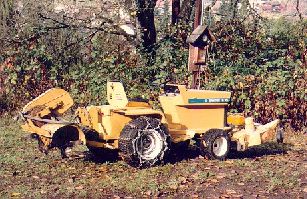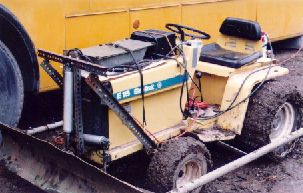GE Electrak
GE Electrak

My relationship with electric tractors goes back almost 30 years, when I purchased a used General Electric ElecTrak E-14. I had been care taking 2 acres of property, and was tired of always having to borrow a lawnmower, which I would then have to lug home in the back of the car, fill with gasoline from a can that always seemed to leak on the car or me, then walk around behind the machine getting fumigated by exhaust, while trying to not shear off my toes or other body parts during the mowing process. This tractor was in good condition, although it needed a new set of batteries, as the existing ones were a bit tired. The biggest obstacle in electric cars is weight, but in a tractor, weight is your friend! Since speeds are low, more weight is better traction. The chains on the rear tires aren't for looks, this thing will climb trees in low gear. In fact, I have used it a number of times as a skidder to haul logs out of the woods!
Manufacturer: Well, everybody knows who General Electric is, they're the nice folks who built so many of those nuclear reactors that utilities thought would make such good sources of cheap and clean electrical power. Apparently, there were some radicals inside GE, and they convinced somebody to allow them to manufacture these tractors for a few years in the 1970's. At some point, the radicals were found out, and GE sold the ElecTrak line to Wheel Horse, who promptly extinguished the entire idea, probably because it was a threat to their gasoline-powered tractors. I once talked to a retired GE engineer, who said he saw train car loads of ElecTrak parts being sent back to be smelted into new steel.
Batteries and Charger: This tractor has six 6-volt deep-discharge 220-ampere-hour golf cart batteries, two in front and four under the seat, for a system voltage of 36 volts nominal. An on-board ferro-resonant transformer-based charger is mounted frontmost under the hood. A wind-up timer controls the charger, and I installed a 0-30 amp charge indicator meter.
Motor and Transmission: The motor is a GE (naturally!), shunt-wound, with an equivalent output of 20 horsepower. Power is transferred to the wheels via a Peerless 4 speed differential transmission. A single mechanically-actuated disc brake is mounted on a jackshaft of the transmission. If anything on this tractor could be better engineered, it would be the brakes. No amount of adjusting has ever made it stop worth a damn. Most of the time it has next to no brakes at all, and I have run down small trees, crashed forward and backwards through sticker bushes, and clobbered immoveable objects due to the lack thereof. Maybe one day I'll adapt some motorcycle brakes to work on it. Fortunately, it does have some regenerative braking, so I can normally control it on hills, and in a emergency, throw it into reverse.
Controller: The controller is quite primitive, being three stages of series resistance in the armature circuit, full armature current, and then four stages of resistive field weakening. All throttle positions are selected via a throttle pedal. Reverse is selected by use of a toggle switch, and is simply a relay which reverses the polarity of the field coils in the motor, reversing it's rotation. I did design and build a PWM MOSFET controller for this tractor, which worked perfectly, but never have gotten around to installing it.
 Accessories: No lack of accessories here. The tractor came with a three-blade, three-motor, front mounted mower and a four-tine rototiller which uses the same type of motor as the drive motor (a spare!). A 50 amp receptacle is mounted in the front to power these units, and is controlled by a contactor actuated by a dash switch. Front and rear mounted electric winches raise and lower the mower and tiller, and are also useful for things like fence post pulling, winching the tractor out if slippery mud, etc. Here it is fitted with a 60" dozer blade, which is operated by hydraulics from a salvaged hospital bed. A separate 12-volt battery and 600 watt AC inverter power the pump for the hydraulics. Additionally, a variety of powered hand tools were made, including drill motor, hedge trimmer, grass clipper, arc welder, electric chain saw, motor-generator DC-to-AC inverter and a snow blower, although I've never seen or needed one of those. A 15 amp receptacle is mounted on the front to power the smaller tools.
Accessories: No lack of accessories here. The tractor came with a three-blade, three-motor, front mounted mower and a four-tine rototiller which uses the same type of motor as the drive motor (a spare!). A 50 amp receptacle is mounted in the front to power these units, and is controlled by a contactor actuated by a dash switch. Front and rear mounted electric winches raise and lower the mower and tiller, and are also useful for things like fence post pulling, winching the tractor out if slippery mud, etc. Here it is fitted with a 60" dozer blade, which is operated by hydraulics from a salvaged hospital bed. A separate 12-volt battery and 600 watt AC inverter power the pump for the hydraulics. Additionally, a variety of powered hand tools were made, including drill motor, hedge trimmer, grass clipper, arc welder, electric chain saw, motor-generator DC-to-AC inverter and a snow blower, although I've never seen or needed one of those. A 15 amp receptacle is mounted on the front to power the smaller tools.
Oh, my other electric tractor? it's an ElecTrak E-12, mostly the same as the E-15, except it uses a permanent-magnet motor, and has slightly smaller tires. I use it mostly to haul a garden trailer and let the neighborhood kids ride it around the block. I bought it from the local used small tractor dealer, who didn't know what it was or how to fix it. He thought I was an idiot for paying him $135 for it (and said so), until I told him that the mowing deck alone was worth $350 (this was after I paid and loaded it on the trailer).
Original material ©1996-2025 Mr. Sharkey | All rights reserved
